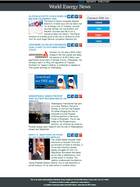Iranians Face Fuel Price Surge as Subsidies Cut
Iranians have rushed to gas stations to fill their cars before a price surge expected at midnight on Thursday, as President Hassan Rouhani pushes ahead with a policy to cut fuel subsidies.
The new prices of subsidised petrol, diesel and compressed natural gas (CNG) have not been announced, but the increases will test Rouhani's support among a population battered by soaring inflation that has been exacerbated by economic sanctions.
With memories of riots at the pumps when cheap fuel was rationed for the first time, in 2007, police are on the alert, but do not expect trouble, Interior Minister Abdolreza Rahmani Fazli said.
"We have been preparing for two months to implement these plans in provinces, cities and rural areas," state news agency IRNA quoted Rahmani Fazli as saying on Thursday
"Considering the planning, it is expected that the second phase of target subsidies will take place without any problems or displeasure from people."
Rouhani's predecessor, Mahmoud Ahmadinejad, last cut subsidies for fuel, food and utilities in December 2010.
There were no riots, but the impact on inflation - which shot up from a record low of 8.8 percent in August 2010 to around 40 percent by the end of his term, exacerbated by tightened Western sanctions - was a major cause of public resentment.
Rouhani, who secured a surprise election win last June, has taken Iran into substantive talks with world powers on Iran's nuclear programme, hoping to get Europe and the United States to lift their sanctions.
He has also made fighting inflation a priority, but the subsidy cut is likely to reverse some of his progress on that front. Inflation currently stands at 35 percent.
"(In 2007) there was chaos everywhere all across Tehran," remembers a 34 year engineer speaking by telephone from the capital. "I guess people learned that they can still live with higher prices," he added.
"It's nice to pay very little for gasoline, but I am willing to pay the right price for the sake of having a better economy in long term."
Expect More
"Of course I don't want prices to go up, but the reality is that the prices have to become real," said a 30-year-old communication specialist in Tehran.
"But I expect more services from the government in return, such as health and transportation."
Rouhani's first attempt at implementing subsidy reform was a disaster.
In February, his government partially replaced cash subsidies with food handouts. Images of people waiting hours for a few bags of groceries tarnished Rouhani's image as a competent manager and left him vulnerable to attacks from hardliners.
The criticism was so widespread Rouhani issued a public apology on state TV.
Currently, motorists with the right to subsidized gasoline receive 60 litres a month at the price of 4,000 rials ($0.16) a litre, or $0.61 a gallon, using the central bank's official exchange rate.
Above that, motorists pay 7,000 rials ($0.28) a litre for gasoline, or $1.02 a gallon.
($1 = 24797.0000 Iranian Rials)
(By Michelle Moghtader; Additional reporting by Mehrdad Balali; Editing by Robin Pomeroy)
